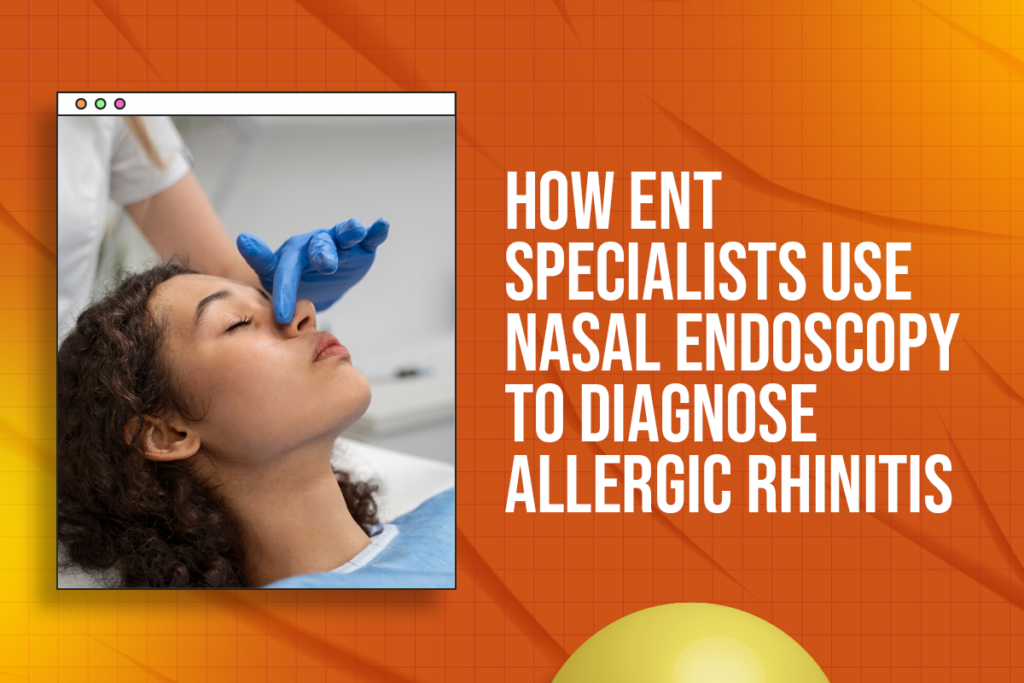Allergic rhinitis is more than just a seasonal annoyance. It can affect your sleep, energy levels, and quality of life. Many people live with constant sneezing, nasal congestion, or postnasal drip without knowing the exact cause. That’s where an ENT specialist steps in—and one of the most effective tools they use is nasal endoscopy.
In this blog, we’ll explore what nasal endoscopy is, why ENT doctors use it, and how it helps accurately diagnose allergic rhinitis in the simplest way possible. If you’re looking for relief from long-term nasal issues, this guide is for you.
What is Allergic Rhinitis?
Allergic rhinitis, commonly called nasal allergies, happens when your immune system reacts to allergens like dust, pollen, pet dander, or mold. The symptoms include:
- Sneezing
- Runny or blocked nose
- Itchy nose or throat
- Watery eyes
- Postnasal drip (mucus dripping at the back of the throat)
If left untreated, it can lead to sinus infections, ear problems, and sleep issues. That’s why a correct and early diagnosis is essential.
Why You Should See an ENT Specialist for Allergic Rhinitis
You might wonder—why not just take over-the-counter allergy meds?
Because sometimes, what feels like an allergy could be sinusitis, nasal polyps, or a deviated septum. Only a trained ENT (Ear, Nose, and Throat) specialist can spot the difference and suggest the right treatment.
ENT doctors have advanced tools like nasal endoscopy that help them look deeper inside your nose without any cuts or pain. That’s something regular doctors can’t do.
What is Nasal Endoscopy?
Nasal endoscopy is a simple, in-clinic procedure where the ENT doctor uses a thin, flexible tube with a tiny camera at the end. This tool is gently inserted into your nose to see the inside of your nasal passages and sinuses.
It helps the doctor find:
- Swelling or inflammation
- Structural problems like a deviated septum
- Polyps or growths
- Blocked sinuses
- Signs of infection or allergies
How ENT Specialists Use Nasal Endoscopy for Diagnosing Allergic Rhinitis
Here’s what typically happens when you go for a nasal endoscopy:
- Preparation: A mild numbing spray is used inside your nose to make the procedure comfortable.
- Insertion: The doctor gently inserts the endoscope and checks the nasal passages.
- Observation: They watch the live video feed to check for signs of allergic inflammation, mucus buildup, or other issues.
- Diagnosis: Based on what they see, they confirm if you have allergic rhinitis or something else like sinusitis or nasal polyps.
This clear visibility helps in creating a personalized treatment plan instead of guessing the cause of your symptoms.
Benefits of Nasal Endoscopy in Allergic Rhinitis Diagnosis
Using nasal endoscopy gives both the doctor and the patient several benefits:
Accurate Diagnosis
It allows direct viewing of the problem inside your nose.
Fast Results
You get immediate insights—no need to wait days for scans.
Non-Invasive
There’s no surgery involved. It’s done right in the clinic.
Better Treatment Planning
Once the problem is clearly identified, treatment becomes more focused and effective.
What Happens After the Diagnosis?
Once your ENT specialist confirms allergic rhinitis, they might recommend:
- Antihistamines or nasal steroid sprays
- Saline nasal washes to clear out allergens
- Avoiding triggers like dust, smoke, or pets
- Immunotherapy in long-term or severe cases
Tips to Manage Allergic Rhinitis Better
Besides medical treatment, you can follow these simple tips at home:
- Use air purifiers to reduce indoor allergens
- Keep windows closed during high-pollen seasons
- Wash your bedding regularly in hot water
- Rinse your nose with saline spray every day
- Shower after going outdoors to remove pollen from your skin and hair
If you’ve been struggling with nasal allergies for a long time, don’t ignore them. Nasal endoscopy is a simple yet powerful tool that helps ENT specialists diagnose allergic rhinitis with clarity. It avoids trial-and-error treatments and gets to the root of your discomfort quickly. Still sneezing? Still congested? It might be time to visit an experienced Allergic Rhinitis Doctor near you.
At our clinic in Nashik, Dr. Sudarshen Aahire uses advanced diagnostic tools like nasal endoscopy to provide accurate, effective, and personalized allergic rhinitis treatment. Book your consultation today and breathe easier tomorrow.
Frequently asked questions
1. Is nasal endoscopy painful?
No. It’s a safe and mostly painless procedure done under local anesthesia spray.
2. How long does the procedure take?
It usually takes just 5 to 10 minutes.
3. Can children undergo nasal endoscopy?
Yes, it’s safe for children when done by an experienced ENT specialist.
4. Will I need it again in the future?
Possibly, especially if your symptoms return or worsen. It helps in monitoring progress.
5. Can allergic rhinitis go away on its own?
It may reduce over time, but most people benefit from proper diagnosis and treatment to avoid complications.
Dr. Sudarshen Aahire is a young, talented, and vibrant ENT and Pediatric doctor in Nashik with 12 years of experience. Apart from routine ENT care and surgeries he specializes in the management of Snoring and obstructive sleep apnea surgeries, Endoscopic skull base surgeries, voice-related disorders, and voice surgeries, airway and swallowing disorders.

